This technical document provides guidelines for choosing the right Cisco Meraki security appliance based on real-world deployments, industry standard benchmarks and in-depth feature descriptions.
Overview
Cisco Meraki MX Security Appliances are Unified Threat Management (UTM) products.
UTM products offer multiple security features in a simple-to-deploy, consolidated form factor. Given the number of security features that can be deployed in any given MX, device performance will vary depending on the use-case. Choosing the right MX depends on the use-case and the deployment characteristics.
This technical guide is designed to help answer the following questions:
- How do I decide which MX model I need?
- Which features should I turn on?
- How do MX models compare against the competition?
Choosing the right hardware
Cisco Meraki MX products come in 6 models. The chart below outlines MX hardware properties for each model:
| MX64 | MX64W | MX65 | MX65W | MX84 | MX100 | MX400 | MX600 | |
| Dual Wan Links | ✓ | ✓ | ✓ | ✓ | ✓ | ✓ | ✓ | ✓ |
| 3G / 4G Failover | ✓ | ✓ | ✓ | ✓ | ✓ | ✓ | ✓ | ✓ |
| Built-In Wireless | ✓ | ✓ | ||||||
| Built-In PoE+ | ✓ | ✓ | ||||||
| Hard drive (TB) | 1 | 1 | 1 | 4 | ||||
| Fiber Connectivity | SFP | SFP | SFP, SFP+ | SFP, SFP+ | ||||
| Dual Power Supply | ✓ | ✓ | ||||||
| Form Factor | Desktop | Desktop | Desktop | Desktop | 1U | 1U | 1U | 2U |
Network performance benchmarks
Industry standard benchmarks are designed to help you compare MX security appliances to firewalls from other vendors. These tests assume perfect network conditions with ideal traffic patterns. When measuring maximum throughput for a certain feature, all other features are disabled. Actual results in production networks will vary.
| MX64(W) | MX65(W) | MX84 | MX100 | MX400 | MX600 | |
| Max throughput with all security features enabled | 200 Mbps | 200 Mbps | 300 Mbps | 650 Mbps | 1 Gbps | 1 Gbps |
| Recommended max clients | 50 | 50 | 200 | 500 | 2,000 | 10,000 |
| Max Stateful (L3) firewall throughput in passthrough mode | 250 Mbps | 250 Mbps | 500 Mbps | 750 Mbps | 1 Gbps | 1 Gbps |
| Max Stateful (L3) firewall throughput in NAT mode | 200 Mbps | 200 Mbps | 500 Mbps | 750 Mbps | 1 Gbps | 1 Gbps |
| Max connections | 100,000 | 100,000 | 250,000 | 500,000 | 1,000,000 | 2,000,000 |
| Max connections per second | 5,000 | 5,000 | 8,000 | 12,000 | 30,000 | 30,000 |
| Max VPN throughput | 100 Mbps | 100 Mbps | 250 Mbps | 500 Mbps | 1 Gbps | 1 Gbps |
| Max VPN connections (site-to-site or client VPN) | 25 | 25 | 50 | 250 | 1,000 | 5,000 |
| Max AV throughput | 250 Mbps | 250 Mbps | 500 Mbps | 750 Mbps | 1 Gbps | 1 Gbps |
| Max IDS throughput | 200 Mbps | 200 Mbpsp | 300 Mbps | 650 Mbpsp | 1 Gbps | 1 Gbps |
Features, benefits and performance impact
UTM products come with a variety of security and networking features. Understanding the benefits and tradeoffs of these features is crucial to getting the maximum security benefit without unnecessary performance degradation.
| BENEFITS | PERFORMANCE IMPACT | RECOMMENDATIONS | |
| Anti-virus / anti-phishing | Provides flow based protection for Web traffic (port 80).s | High | Consider disabling for guest VLANs and using firewall rules to isolate those VLANs. Also consider disabling AV/anti-phishing if you run a full AV client on host devices. |
| IDS / IPS | Provides alerts / prevention for suspicious network traffic | High | Consider not sending IDS/IPS syslog data over VPN in low-bandwidth networks. |
| VPN | Secure, encrypted traffic between locations | Medium | Use split-tunnel VPN and deploy security services at the edge. |
| Web caching | Accelerating access to Web content by caching locally | Medium | Ideal for repetitively accessing heavy multimedia content frequently for low bandwidth networks. Not recommended for high bandwidth networks. Please note that YouTube doesn’t support web caching. |
| Content filtering (top sites) | Category based URL filtering using locally downloaded database | Low | Choose this option if your priority is speed over coverage. |
| Content filtering (full list) | Category based URL filtering using the full database hosted at Brightcloud.com | Medium | Choose this option if your priority is 100% coverage and security. Web browsing will be slightly slower at the beginning but will improve as more and more URL categories are cached. |
| Web safe-search | Turning Google / Bing safesearch option on | Low | Must be deployed in tandem with “disable encrypted search” option to be effective. |
| Blocking encrypted search | Disabling Google / Bing searches via https (port 443), allowing Web safesearch enforcement | Low | Must be deployed in tandem with “Web safe-search” to be effective. Requires a DNS setting modification, otherwise will also break Google apps. Check Meraki knowledge base for further information. |
Real-world Use Cases
In this section, we’ll cover the most common deployment use cases for the Meraki MX:
- “Everything on”
- K-12 school with limited bandwidth
- K-12 school with high bandwidth
- College / higher education institution
- Retail branch
- Head-end concentrator for retail branches
For each case, we’ll articulate which features should be turned on and measure the maximum throughput achieved with each MX model.
USE CASE: “Everything On”
Often, administrators would like to know what network throughput would look like if they turned on all of the features of their MX security appliance (worst-case scenario). Please refer to the “Features, benefits, and the performance impact” table in this document when fine-tuning the firewall configuration to achieve maximum security without unnecessary performance degradation
FIREWALL CONFIGURATION
Security features enabled:
- NAT mode
- Split-tunnel VPN
- Content filtering
- Traffic shaping
- Anti-virus/anti-phishin
- IPS
- Web caching (not available on MX64/MX64W)
TEST TRAFFIC PATTERN
Traffic flowing through the MX security appliance for testing purposes was composed of the following protocols/applications.
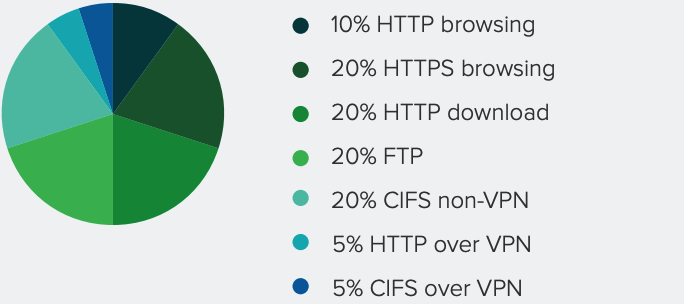
THROUGHPUT CONFIGURATION
| MX64(W) | MX65(W) | MX84 | MX100 | MX400 | MX600 | |
| Max throughput | 200 Mbps | 200 Mbps | 320 Mbps | 650 Mbps | 1 Gbps | 1 Gbps |
| Client count | 50 | 50 | 200 | 500 | 2,000 | 10,000 |
USE CASE: K-12 school with limited bandwidth
Schools need strong URL filtering, application control and security features. In addition, schools with low bandwidth also need traffic shaping and web caching.
FIREWALL CONFIGURATION
Security features enabled:
|
|
TEST TRAFFIC PATTERN
Traffic flowing through the MX security appliance for testing purposes was composed of the following protocols/applications. The traffic is heavily skewed towards HTTP/S (70%).
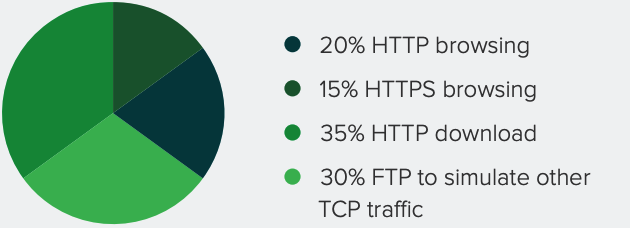
THROUGHPUT CONFIGURATION
| MX64(W) | MX65(W) | MX84 | MX100 | MX400 | MX600 | |
| Max throughput | 200 Mbps | 200 Mbps | 450 Mbps | 750 Mbps | 1 Gbps | 1 Gbps |
| Client count | 50 | 50 | 200 | 500 | 2,000 | 10,000 |
USE CASE: K-12 school with high bandwidth
Schools with high-bandwidth may not need Web caching or traffic shaping.
FIREWALL CONFIGURATION
Security features enabled:
- NAT mode
- Split-tunnel VPN
- Content filtering
- Layer 7 Firewall
- Anti-virus/anti-phishin
- Google safe-search
- YouTube for Schools
TEST TRAFFIC PATTERN
Traffic flowing through the MX security appliance for testing purposes was composed of the following protocols/applications. The traffic is heavily skewed towards HTTP/S (70%).

THROUGHPUT CONFIGURATION
| MX64(W) | MX65(W) | MX84 | MX100 | MX400 | MX600 | |
| Max throughput | 200 Mbps | 200 Mbps | 450 Mbps | 750 Mbps | 1 Gbps | 1 Gbps |
| Client count | 50 | 50 | 200 | 500 | 2,000 | 10,000 |
USE CASE: Higher-Ed firewall
Higher-Ed institutions traditionally don’t filter Web content due to freedom of speech concerns. Also, most Higher-Ed institutions have very high-throughput Internet access, so there is no need to do traffic shaping or Web caching.
FIREWALL CONFIGURATION
Security features enabled:
- NAT mode
- Anti-virus/anti-phishing
- Layer 7 Firewall
TEST TRAFFIC PATTERN
Traffic (for testing purposes) was composed of the following protocols/applications. Compared to the previous scenario, there is more multimedia streaming (simulating a typical dorm use case).
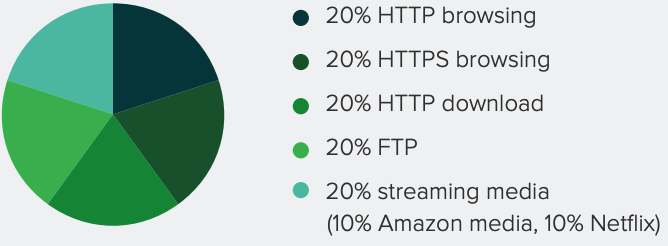
THROUGHPUT CONFIGURATION
| MX64(W) | MX65(W) | MX84 | MX100 | MX400 | MX600 | |
| Max throughput | 200 Mbps | 200 Mbps | 450 Mbps | 750 Mbps | 1 Gbps | 1 Gbps |
| Client count | 50 | 50 | 200 | 500 | 2,000 | 10,000 |
USE CASE: Retail branch with guest access
Retailers are looking for a cost-effective yet secure solution to provide reliable VPN access for corporate applications like POS transactions, while offering a guest wireless access that is safe and filtered from inappropriate content.
FIREWALL CONFIGURATION
Security features enabled:
- NAT mode
- Split-tunnel VPN
- Content filtering
- Traffic shaping (max throughput on guest VLAN)
- Anti-virus/anti-phishing
- IPS
TEST TRAFFIC PATTERN
In this use case, retail traffic is a mixture of guest traffic (HTTP/S) as well as VPN traffic for file transfers, nightly backups and other corporate data.
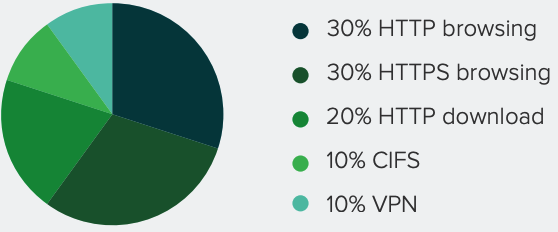
THROUGHPUT CONFIGURATION
| MX64(W) | MX65(W) | MX84 | MX100 | MX400 | MX600 | |
| Max throughput | 200 Mbps | 200 Mbps | 320 Mbps | 650 Mbps | 1 Gbps | 1 Gbps |
| Client count | 50 | 50 | 200 | 500 | 2,000 | 10,000 |
USE CASE: Head-end concentrator for retail branches
MX is deployed in the datacenter as a one-armed VPN aggregator, possibly as an Active / Passive HA pair.
FIREWALL CONFIGURATION
Security features enabled:
- VPN concentrator mode
- Full-tunnel VPN
TEST TRAFFIC PATTERN
All traffic is via VPN, including HTTP/S for Web browsing and download, and considerable amount of file transfers to simulate backup and other corporate data exchange.
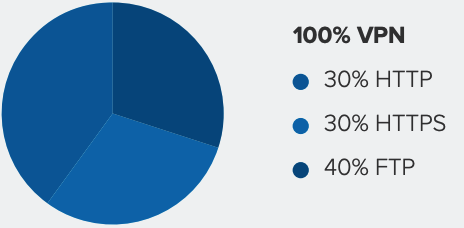
THROUGHPUT CONFIGURATION
| MX64(W) | MX65(W) | MX84 | MX100 | MX400 | MX600 | |
| Max VPN throughput | 100 Mbps | 100 Mbps | 220 Mbps | 500 Mbps | 1 Gbps | 1 Gbps |
| Max per-tunnel VPN throughput | 85 Mbps | 85 Mbps | 200 Mbps | 375 Mbps | 900 Mbps | 900 Mbps |
| Max VPN Sessions | 25 | 25 | 100 | 375 | 1,000 | 5,000 |
Conclusion
While every network will have a unique traffic pattern, this guide highlights a few common scenarios to help you choose the right Cisco Meraki MX product for your environment. Consider planning for future growth by allocating buffer room in your firewall selection (e.g., if you currently have 550 users, choose an MX that supports 1000 users). This will ensure that you can continue enabling additional security and network features as they become available. Also considering ISP speeds are increasing 29% year over year, it is important to choose a firewall that will serve you well over many years to come.
